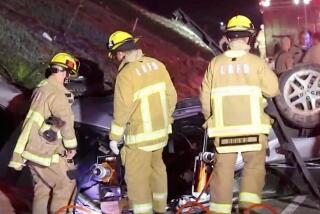The Original Superhighway : How Botts’ Dots and Other Devices Improve Flow and Safety of Area Freeways
You enter a San Fernando Valley freeway only after a ramp meter gives you the go-ahead, gradually making your way through traffic to the left lane. You drift too close to the median, which nudges you back into your lane. Changing radio stations for some traffic advice, you drift toward the adjacent lane, but raised lane marker dots keep you in line. An electronic message sign warns of stopped traffic ahead, so you decide to exit, when . . . boom, a flat tire. You pull off to use a call box which, with the push of a button, puts you in touch with highway patrol.
Drivers may take it for granted, but they benefit from freeway safety and convenience technology pioneered right here in Los Angeles. In the 54 years since the state’s first freeway, the Pasadena, was built, freeway transportation has moved toward “smart” technology that puts cars in close communication with transportation centers.
Before the automobile arrived in Los Angeles in 1900, an expedition across the San Fernando Valley could take as long as a day. It still may seem that way to Valley travelers in heavy traffic, but traffic monitoring devices improve traffic speeds about 15%.
How does the technology work, who monitors it, and what may be on the horizon? A freeway technology guide for the Valley driver tells it all:
Jersey Barriers & Gawk Screens
* The 3.5-foot-tall concrete medians are fluted at the bottom to ease cars that bump into them back onto the roadway.
* Green plastic baffles or mesh screens are often placed on top of medians to prevent motorists from gawking at incidents on the other side of the freeway.
Closed-circuit Cameras
* Cameras are linked to a microwave transmitter, which sends video signals to Caltrans Traffic Operations Center.
* Caltrans can respond by dispatching tow trucks, CHP units, ambulances, etc.
* There are 17 cameras on the Santa Monica Freeway, downtown interchanges and on the Golden State Freeway. More are being installed on the Golden State Freeway.
Call Boxes
* Originally installed in 1962, all of the 4,000 boxes along highways have been replaced with new solar-powered cellular models.
* The boxes are made of vandal-resistant plastic and are attached to breakaway poles.
* The improved boxes have bilingual usage instructions and screen out freeway noise.
Botts’ Dots
* There are more than 3 million Botts’ Dots dividing Los Angeles freeway lanes.
* Developed by Caltrans engineer Elbert D. Botts in the early 1950s, but not used until 1965 when a successful asphalt adhesive was developed.
* Rows of four ceramic dots and a reflective plastic one are installed every 48 feet.
* They last about six years and cost $1.50 apiece for a ceramic dot, $3.50 for a plastic reflective one.
Traffic Operations Center
* This is the transportation nerve center downtown where Caltrans works in conjunction with the CHP.
* The center uses a large electronic map of the region’s freeways, on which colored lights correspond to current freeway speeds.
Changeable Message Signs
* Signs alert motorists to problem traffic conditions and recommend detours.
* Messages are programmed by operators at the Caltrans Traffic Operations Center downtown.
* Currently there are 62 signs, with plans to add another 43 by 2001.
Ramp Meters
* Introduced in 1966, today there are more than 1,000 such meters statewide.
* Meters are timed based on traffic flow, which is picked up by loop detectors in pavement. Caltrans’ central computer downtown analyzes traffic flow and sets signals accordingly.
Electromagnetic Loop Detectors
* Wire loops below the road’s surface are linked by phone line to the operations center.
* They register the flow of traffic and can detect when traffic is at a standstill.
Sources: Caltrans; California Highway Patrol; “The San Fernando Valley Then and Now”
More to Read
Sign up for Essential California
The most important California stories and recommendations in your inbox every morning.
You may occasionally receive promotional content from the Los Angeles Times.










